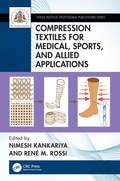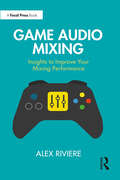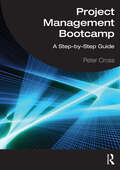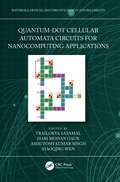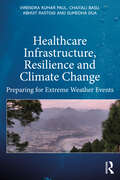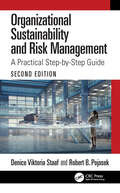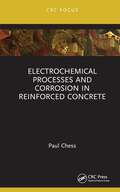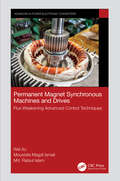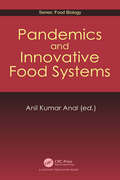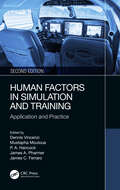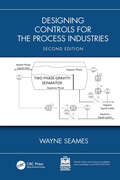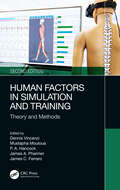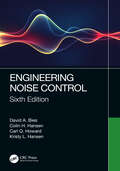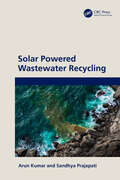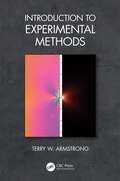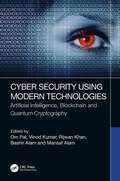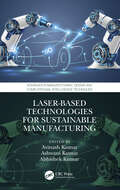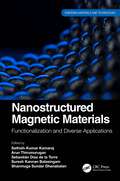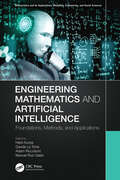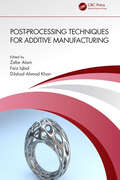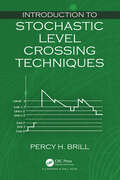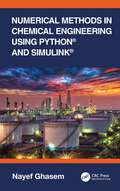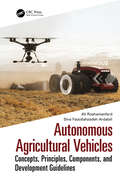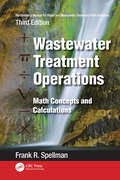- Table View
- List View
Compression Textiles for Medical, Sports, and Allied Applications (Textile Institute Professional Publications)
by Nimesh Kankariya and René RossiTextile-based compression therapy is used in a range of applications, such as for athlete and sport recovery, enhanced proprioception, compression spacesuits, and in the management of chronic diseases. This book provides an overview of compression devices and products, testing methods to measure the properties of materials used in compression devices, and design considerations based on dynamic body measurements. It also includes a model for predicting pressure and details the challenges in applying compression for various applications. Chapters in this book: Discuss the science behind compression therapy Delve into the materials used in compression devices and products and assesses their performance based on their properties and structure Cover theoretical modeling to predict the pressure exerted by compression devices on the human body Consider compression textile design based on dynamic body measurements This book is aimed at professionals and researchers in textile engineering, materials engineering, biotechnology, and the development of textile-based compression devices and products, and at such medical practitioners as phlebologists.
Game Audio Mixing: Insights to Improve Your Mixing Performance
by Alex RiviereGame Audio Mixing offers a holistic view of the mixing process for games, from philosophical and psychological considerations to the artistic considerations and technical processes behind acoustic rendering, interactive mixing, mastering, and much more. This book includes a comprehensive overview of many game audio mixing techniques, processes, and workflows, with advice from audio directors and sound supervisors. Through a series of accessible insights and interviews, the reader is guided through cutting-edge tips and tricks to equip them to improve their own mixing practice. As well as covering how to plan and create a mix that is clear, focused, and highly interactive, this book provides information about typical mixing tools and techniques, such as dealing with bus structure, frequency spectrum, effects, dynamic, volume, 2D and 3D spaces, and automations. Key information about how to deal with a large number of sounds and their prioritization in the mix is also included, from high-level mixing visions to in-depth designs with sound categorizations at the core. Game Audio Mixing is essential reading for all game audio professionals, including those new to the industry, as well as experienced professionals working on AAA and indie titles, in addition to aspiring professionals and hobbyists.
Project Management Bootcamp: A Step-by-Step Guide
by Peter CrossProject Management Bootcamp is a pragmatic guide for those who need to understand how to deliver projects successfully. The reader journeys through a project stage by stage, discovering what project managers commonly need to achieve at each step. Each step is supported by tables, charts, tips, and tools, which readers may adopt or adapt to their needs, and different ways of organising and delivering projects, including agile approaches, are considered. Because theory can only get you so far, a key element of the book is learning from real projects drawing on the experience of project managers working across three continents. Each chapter ends with challenges to readers to reflect on their learning, which can be based on a theoretical case study or their own project. The result is a reflective framework that charts their learning and their project management journey from initiation to closure. Project Management Bootcamp is essential reading for junior and mid-level career project managers, as well as any professionals who finds themselves in charge of a project and are unsure how to get the best result. Students in business and management courses at undergraduate and postgraduate levels will also value its setting of theory into a practical context.
Quantum-Dot Cellular Automata Circuits for Nanocomputing Applications (Materials, Devices, and Circuits)
by Xiaoqing Wen Ashutosh Kumar Singh Trailokya Nath Sasamal Hari Mohan GaurThis book provides a composite solution for optimal logic designs for Quantum-Dot Cellular Automata based circuits. It includes the basics of new logic functions and novel digital circuit designs, quantum computing with QCA, new trends in quantum and quantum-inspired algorithms and applications, and algorithms to support QCA designers. Futuristic Developments in Quantum-Dot Cellular Automata Circuits for Nanocomputing includes QCA-based new nanoelectronics architectures that help in improving the logic computation and information flow at physical implementation level. The book discusses design methodologies to obtain an optimal layout for some of the basic logic circuits considering key metrics such as wire delays, cell counts, and circuit area that help in improving the logic computation and information flow at physical implementation level. Examines several challenges toward QCA technology like clocking mechanism, floorplan which would facilitate manufacturability, Electronic Design Automation (EDA) tools for design and fabrication like simulation, synthesis, testing etc. The book is intended for students and researchers in electronics and computer disciplines who are interested in this rapidly changing field under the umbrella of courses such as emerging nanotechnologies and its architecture, low-power digital design. The work will also help the manufacturing companies/industry professionals, in nanotechnology and semiconductor engineers in the development of low power quantum computers.
Healthcare Infrastructure, Resilience and Climate Change: Preparing for Extreme Weather Events
by Virendra Kumar Paul Abhijit Rastogi Sumedha Dua Chaitali BasuThis book highlights the vulnerability of healthcare buildings in the context of climate change-triggered extreme weather events (EWEs) and the case for mitigation. With a concise discussion on climate change and its consequences in the form of such events, a cost model and equations that register losses and help quantify them are then presented. The model can be used to estimate the significant potential loss that might occur during an EWE and help healthcare facilities prepare for them. The book analyses cases of major EWEs in India over the last two decades and collates the data available into various categories. Through this research the authors have developed a framework which assists healthcare facilities with a detailed calculation of value losses, both tangible and intangible. The framework can be used to assess the impacts on healthcare buildings in terms of disruption of services so that appropriate decisions related to the resilience in healthcare planning can be taken into consideration. Thus, the book is useful for directing planning and design processes aimed at continuity of service and building resilience to perform in the face of natural disaster and extreme weather. The purpose of this book is to prompt facilities planners and healthcare facilities to prepare to respond to EWEs through the planning and design process in a rational manner. Built infrastructure professionals such as architects and engineers, policy makers, and academics with an interest in disasters, risk and climate change will all find this book to be key reading.
Organizational Sustainability and Risk Management: A Practical Step-by-Step Guide
by Robert B. Pojasek Denice Viktoria StaafThis new edition is completely revamped and reorganized to reflect the change in standards and regulations and to include all new topics related to organizational sustainability and risk management. The role that the Sustainable Development Goals (SDGs) play within the realm of organizational sustainability is one of many new topics. Organizational Sustainability and Risk Management: A Practical Step-by-Step Guide, Second Edition will continue to remind all stakeholders how organizations work through a measurement transformation that affects everything they do including following the International Organization for Standardization’s (ISO) Guide for Sustainability and climate change. The book is enriched with a discussion on life cycle thinking that has been introduced in the ISO high-level structure. Discussions on a fundamental change in how organizations approach sustainability and how we view organizational sustainability are covered. This book offers a platform for managing all activities, products, and services tailored to the needs of the organization and presents how important environmental, social, and governance (ESG) standards are to determine the potential for increased financial growth of organizations that have implemented organizational sustainability. The book is for professionals and can be used in continuing education sustainability courses as well as company-provided short courses where the new regulations for sustainability and ESG reporting are addressed.
Electrochemical Processes and Corrosion in Reinforced Concrete
by Paul ChessSome reinforced concrete structures prematurely corrode as they age, with significant financial implications, but it is not immediately clear why some are more durable than others. This book looks at the various mechanisms for corrosion and how what seemed to be a relatively simple matter has become more complex the further it is understood due to the properties of concrete, steel and the way reinforced concrete structures are constructed. The significance of electrochemical processes is identified with recent research using new technology discussed. Specialist contractors, consultants and owners of corrosion damaged structures will find this an extremely useful resource. It will also be a valuable reference for students at postgraduate level.
IoT and Analytics in Renewable Energy Systems (Volume 1): Sustainable Smart Grids & Renewable Energy Systems
by O. V. Gnana SwathikaSmart grid technologies include sensing and measurement technologies, advanced components aided with communications and control methods along with improved interfaces and decision support systems. Smart grid techniques support the extensive inclusion of clean renewable generation in power systems. Smart grid use also promotes energy saving in power systems. Cyber security objectives for the smart grid are availability, integrity and confidentiality. Five salient features of this book are as follows: AI and IoT in improving resilience of smart energy infrastructure IoT, smart grids and renewable energy: an economic approach AI and ML towards sustainable solar energy Electrical vehicles and smart grid Intelligent condition monitoring for solar and wind energy systems
Permanent Magnet Synchronous Machines and Drives: Flux Weakening Advanced Control Techniques (Advances in Power Electronic Converters)
by Wei Xu Md. Rabiul Islam Moustafa Magdi IsmailPermanent magnet synchronous motors (PMSMs) are popular in the electric vehicle industry due to their high-power density, large torque-to-inertia ratio, and high reliability. This book presents an improved field-oriented control (FOC) strategy for PMSMs that utilizes optimal proportional-integral (PI) parameters to achieve robust stability, faster dynamic response, and higher efficiency in the flux-weakening region. The book covers the combined design of a PI current regulator and varying switching frequency pulse-width modulation (PWM), along with an improved linear model predictive control (MPC) strategy. Researchers and graduate students in electrical engineering, systems and control, and electric vehicles will find this book useful. Features: • Implements evolutionary optimization algorithms to improve PMSM performance. • Provides coverage of PMSM control design in the flux-weakening region. • Proposes a modern method of model predictive control to improve the dynamic performance of interior PMSM. • Studies the dynamic performance of two kinds of PMSMs: surface-mounted and interior permanent magnet types. • Includes several case studies and illustrative examples with MATLAB®. This book is aimed at researchers, graduate students, and libraries in electrical engineering with specialization in systems and control and electric vehicles.
Pandemics and Innovative Food Systems (Food Biology Series)
by Anil Kumar AnalThe debate on health, nutrition and food security could not have arisen at a more opportune time. The recent pandemic has given rise to increased food and nutrition insecurity for individuals, families, and communities. The crisis threatened the food security and nutrition of millions of people, many of whom were already suffering. We face possible disruptions to the functioning of food systems, with severe consequences for health and nutrition. Pandemics create a greater burden for poorer countries and countries since they are already pressure of inadequate food supplies. With concerted action, we can not only avoid some of the worst impacts but do so in a way that supports a transition to more sustainable food systems that are in better balance with nature and that support healthy diets – and thus better health prospects for all. This book aims to highlight the impact of pandemics in food systems and nutrition security. It draws on the experience from the past and present pandemics to better prepare the world for future crises.
Human Factors in Simulation and Training: Application and Practice
by Dennis Vincenzi, Mustapha Mouloua, P. A. Hancock, James A. Pharmer, and James C. FerraroHuman Factors in Simulation and Training: Application and Practice covers the latest applications and practical implementations of advanced technologies in the field of simulation and training. The text focuses on descriptions and discussions of current applications and the use of the latest technological advances in simulation and training. It covers topics including space adaptation syndrome and perceptual training, simulation for battle-ready command and control, healthcare simulation and training, human factors aspects of cybersecurity training and testing, design and development of algorithms for gesture-based control of semi-autonomous vehicles, and advances in the after-action review process for defence training. The text is an ideal read for professionals and graduate students in the fields of ergonomics, human factors, computer engineering, aerospace engineering, occupational health, and safety.
Designing Controls for the Process Industries
by Wayne SeamesOffering a modern, process-oriented approach emphasizing process control scheme development instead of extended coverage of LaPlace space descriptions of process dynamics, Designing Controls for the Process Industries focuses on aspects that are most important for contemporary practical process engineering and reflects the industry’s use of digital distributed control-based systems. The second edition now features 60 tutorial videos demonstrating solutions to most of the example problems. Instead of starting with the controller, the book starts with the process and moves on to how basic regulatory control schemes can be designed to achieve the process objectives while maintaining stable operations. In addition to continuous control concepts, process and control system dynamics are embedded into the text with each new concept presented. The book alsoincludes sections on batch and semi-batch processes and safety automation within each concept area. It discusses the four most common control techniques: control loop feedback, feedforward, ratio, and cascade, and discusses application of these techniques for process control schemes for the most common types of unit operations. It also discusses more advanced andless commonly used regulatory control options such as override, allocation, and split range controllers; includes an introduction to higher-level automation functions; and provides guidance for ways to increase the overall safety, stability, and efficiency for many process applications. It introduces the theory behind the most common types of controllers used in the process industries and provides various additional plant automation-related subjects. The new edition also includes new homework problems and examples, including multiple choice questions for flipped classes, information about statistical process control, and a new case study that documents the development of regulatory control schemes for an entire process area. Aimed at chemical engineering students in process control courses, as well as practicing process and control engineers, this textbook offers an alternative to traditional texts and offers a practical, hands-on approach to design of process controls. PowerPoint lecture slides, multiple-choice quiz questions for each chapter, and a solutions manual are available to qualifying instructors. Tutorial-style videos for most of the text examples are available for all readers to download.
Human Factors in Simulation and Training: Theory and Methods
by Dennis Vincenzi, Mustapha Mouloua, P. A. Hancock, James A. Pharmer, and James C. FerraroHuman Factors in Simulation and Training: Theory and Methods covers theoretical concepts on human factors principles as they apply to the fields of simulation and training in the real world. This book discusses traditional and nontraditional aspects of simulation and training. Topics covered include simulation fidelity, transfer of training, limits of simulation and training, virtual reality in the training environment, simulation-based situation awareness training, automated performance measures, performance assessment in simulation, adaptive simulation-based training, and scoring simulations with artificial intelligence This book will be a valuable resource for professionals and graduate students in the fields of ergonomics, human factors, computer engineering, aerospace engineering and occupational health and safety.
Engineering Noise Control: Theory And Practice, Fourth Edition
by Colin H. Hansen Kristy L. Hansen David A. Bies Carl Q. HowardThis classic and authoritative textbook contains material that is not over-simplified and can be used to solve real-world noise control engineering problems. Engineering Noise Control, 6th edition covers theoretical concepts, and practical application of current noise control technology. Topics extensively covered or revised from the 5th edition include: beating; addition and subtraction of noise levels; combining multi-path noise level reductions; hearing damage assessment and protection; speech intelligibility; noise weighting curves; instrumentation, including MEMS, IEPE and TEDS sensors; noise source types, including transportation noise and equipment noise estimations; outdoor sound propagation, including noise barriers, meteorological effects and sloping ground effects; sound in rooms, muffling devices, including 4-pole analysis, self noise and pressure drop calculations; sound transmission through single, double and triple partitions; vibration measurement and control, finite element analysis; boundary element methods; and statistical energy analysis. Discusses all aspects of industrial and environmental noise control An ideal textbook for advanced undergraduate and graduate courses in noise control An excellent reference text for acoustic consultants and engineers Practical applications are used to demonstrate theoretical concepts Includes material not available in other books A wide range of example problems and solutions that are linked to noise control practice are available for download from www.causalsystems.com.
Solar Powered Wastewater Recycling
by Arun Kumar Sandhya PrajapatiThe United Nations predicts that by the year 2025, two-thirds of the world’s population will face water scarcity. Further, the planet would have well over eight billion people, the majority of whom would live in developing countries, where more than 80% of those are already experiencing water scarcity. Therefore, there is an urgent need for wastewater recycling to help solve issues of scarcity and to facilitate better management of generated wastewater. Water recycling includes reuse and treatment of municipal wastewater, which could be a sustainable approach for environmental sustainability and could also help to offset the increasing water demands for irrigation and industrial and other needs. Currently, water and wastewater treatment facilities consume large amounts of energy that are mainly generated through the use of fossil fuels. Solar Powered Wastewater Recycling examines how solar power can be implemented as an integrated approach whereby all the energy needs of the water and wastewater sector could be supplemented by renewable technologies, and in which a synergy can be developed between water and energy.
Introduction to Experimental Methods
by Terry W. ArmstrongIntroduction to Experimental Methods succinctly explains fundamental engineering concepts in mechanics, dynamics, heat transfer, and fluid dynamics. From conceptualizing an engineering experiment to conducting a comprehensive lab, this book enables students to work through the entire experimental design process.Offering a complete overview of instruction for engineering lab methodology, the book includes practical lab manuals for student use, directly complementing the instruction. Numerous worked examples and problems are presented along with several hands-on experiments in individual lab manuals. This book discusses how to write lab reports, how to configure a variety of instruments and equipment, and how to work through failures in experimentation.Introduction to Experimental Methods is intended for senior undergraduate engineering students taking courses in Experimental Methods. Instructors will be able to utilize a Solutions Manual for their course.Features: Provides an overview of experimental methods in mechanics, dynamics, heat transfer, and fluid dynamics Covers design of experiments, instruments, and statistics Discusses SolidWorks and PASCO Capstone software Includes numerous end-of-chapter problems and worked problems Features a Solutions Manual for instructor use
Cyber Security Using Modern Technologies: Artificial Intelligence, Blockchain and Quantum Cryptography
by Vinod Kumar Mansaf Alam Om Pal Rijwan Khan Bashir AlamThe main objective of this book is to introduce cyber security using modern technologies such as Artificial Intelligence, Quantum Cryptography, and Blockchain. This book provides in-depth coverage of important concepts related to cyber security. Beginning with an introduction to Quantum Computing, Post-Quantum Digital Signatures, and Artificial Intelligence for cyber security of modern networks and covering various cyber-attacks and the defense measures, strategies, and techniques that need to be followed to combat them, this book goes on to explore several crucial topics, such as security of advanced metering infrastructure in smart grids, key management protocols, network forensics, intrusion detection using machine learning, cloud computing security risk assessment models and frameworks, cyber-physical energy systems security, a biometric random key generator using deep neural network and encrypted network traffic classification. In addition, this book provides new techniques to handle modern threats with more intelligence. It also includes some modern techniques for cyber security, such as blockchain for modern security, quantum cryptography, and forensic tools. Also, it provides a comprehensive survey of cutting-edge research on the cyber security of modern networks, giving the reader a general overview of the field. It also provides interdisciplinary solutions to protect modern networks from any type of attack or manipulation. The new protocols discussed in this book thoroughly examine the constraints of networks, including computation, communication, and storage cost constraints, and verifies the protocols both theoretically and experimentally. Written in a clear and comprehensive manner, this book would prove extremely helpful to readers. This unique and comprehensive solution for the cyber security of modern networks will greatly benefit researchers, graduate students, and engineers in the fields of cryptography and network security.
Laser-based Technologies for Sustainable Manufacturing (Advances in Manufacturing, Design and Computational Intelligence Techniques)
by Ashwani Kumar Abhishek Kumar Avinash KumarThis book provides scientific and technological insights on novel techniques of design and manufacturing using laser technologies. It showcases applications of laser micromachining in the biomedical industry, laser-based manufacturing processes in aerospace engineering, and high-precision laser-cutting in the home appliance sector. Features: Each chapter discusses a specific engineering problem and showcases its numerical, and experimental solution Provides scientific and technological insights on novel routes of design and manufacturing using laser technologies Synergizes exploration related to the various properties and functionalities through extensive theoretical and numerical modeling Highlights current issues, developments, and constraints in additive manufacturing Discusses applications of laser cutting machines in the manufacturing industry and laser micromachining for the biomedical industry The text discusses optical, and laser-based green manufacturing technologies and their application in diverse engineering fields including mechanical, electrical, biomedical, and computer. It further covers sustainability issues in laser-based manufacturing technologies and the development of laser-based ultra-precision manufacturing techniques. The text also discusses the use of artificial intelligence and machine learning in laser-based manufacturing techniques. It will serve as an ideal reference text for senior undergraduate, graduate students, and researchers in fields including mechanical engineering, aerospace engineering, manufacturing engineering, and production engineering.
Nanostructured Magnetic Materials: Functionalization and Diverse Applications (Emerging Materials and Technologies)
by Sathish-Kumar Kamaraj Arun Thirumurugan Shanmuga Sundar Dhanabalan Suresh Kannan Balasingam Sebastián Díaz de la TorreFunctionalized magnetic nanomaterials are used in data storage, biomedical, environmental, and heterogeneous catalysis applications but there remain developmental challenges to overcome. Nanostructured Magnetic Materials: Functionalization and Diverse Applications covers different synthesis methods for magnetic nanomaterials and their functionalization strategies and highlights recent progress, opportunities, and challenges to utilizing these materials in real-time applications. • Reviews recent progress made in the surface functionalization of magnetic nanoparticles. • Discusses physico-chemical characterization and synthesis techniques. • Presents the effect of the external magnetic field. • Details biological, energy, and environmental applications as well as future directions. This reference will appeal to researchers, professionals, and advanced students in materials science and engineering and related fields.
Engineering Mathematics and Artificial Intelligence: Foundations, Methods, and Applications (Mathematics and its Applications)
by Adam Riccoboni Herb Kunze Davide La Torre Manuel Ruiz GalánThe fields of Artificial Intelligence (AI) and Machine Learning (ML) have grown dramatically in recent years, with an increasingly impressive spectrum of successful applications. This book represents a key reference for anybody interested in the intersection between mathematics and AI/ML and provides an overview of the current research streams. Engineering Mathematics and Artificial Intelligence: Foundations, Methods, and Applications discusses the theory behind ML and shows how mathematics can be used in AI. The book illustrates how to improve existing algorithms by using advanced mathematics and offers cutting-edge AI technologies. The book goes on to discuss how ML can support mathematical modeling and how to simulate data by using artificial neural networks. Future integration between ML and complex mathematical techniques is also highlighted within the book. This book is written for researchers, practitioners, engineers, and AI consultants.
Post-processing Techniques for Additive Manufacturing
by Zafar Alam Faiz Iqbal Dilshad Ahmad KhanThis text defines and covers different themes of post-processing techniques based on mechanical, chemical/electrochemical, and thermal energy. It will serve as an ideal reference text for senior undergraduate and graduate students in diverse engineering fields including manufacturing, industrial, aerospace, and mechanical. This book: covers the fundamentals and advancements in the post-processing techniques for additive manufacturing; explores methods/techniques for post-processing different types of materials used in additive manufacturing processes; gives insight into the process selection criteria for post-processing of additive manufactured products made from different types of materials; discusses hybrid processes used for post-processing of additive manufacturing parts; and highlights post-processing techniques for properties enhancement. The primary aim of the book is to give the readers a well-informed layout of the different post-processing techniques that range from employing mechanical energy to chemical, electrochemical, and thermal energy to perform the intended task.
Introduction to Stochastic Level Crossing Techniques
by Percy H. BrillIntroduction to Stochastic Level Crossing Techniques describes stochastic models and their analysis using the System Point Level Crossing method (abbreviated SPLC or LC). This involves deriving probability density functions (pdfs) or cumulative probability distribution functions (cdfs) of key random variables, applying simple level-crossing limit theorems developed by the author. The pdfs and/or cdfs are used to specify operational characteristics about the stochastic model of interest. The chapters describe distinct stochastic models and associated key random variables in the models. For each model, a figure of a typical sample path (realization, i.e., tracing over time) of the key random variable is displayed. For each model, an analytic (Volterra) integral equation for the stationary pdf of the key random variable is created−by inspection of the sample path, using the simple LC limit theorems. This LC method bypasses a great deal of algebra, usually required by other methods of analysis. The integral equations will be solved directly, or computationally. This book is meant for students of mathematics, management science, engineering, natural sciences, and researchers who use applied probability. It will also be useful to technical workers in a range of professions. Key Features: A description of one representative stochastic model (e.g., a single-server M/G/1 queue; a multiple server M/M/c queue; an inventory system; etc.) Construction of a typical sample path of the key random variable of interest (e.g., the virtual waiting time or workload in queues; the net on-hand inventory in inventory systems; etc.) Statements of the simple LC theorems, which connect the sample-path upcrossing and downcrossing rates across state-space levels, to simple mathematical functions of the stationary pdf of the key random variable, at those state-space levels Creation of (usually Volterra) integral equations for the stationary pdf of the key random variable, by inspection of the sample path Direct analytic solution of the integral equations, where feasible; or, computational solutions of the integral equations Use of the derived stationary pdfs for obtaining operational characteristics of the model
Numerical Methods in Chemical Engineering Using Python® and Simulink®
by Nayef GhasemNumerical methods are vital to the practice of chemical engineering, allowing for the solution of real-world problems. Written in a concise and practical format, this textbook introduces readers to the numerical methods required in the discipline of chemical engineering and enables them to validate their solutions using both Python and Simulink. Introduces numerical methods, followed by the solution of linear and nonlinear algebraic equations. Deals with the numerical integration of a definite function and solves initial and boundary value ordinary differential equations with different orders. Weaves in examples of various numerical methods and validates solutions to each with Python and Simulink graphical programming. Features appendices on how to use Python and Simulink. Aimed at advanced undergraduate and graduate chemical engineering students, as well as practicing chemical engineers, this textbook offers a guide to the use of two of the most widely used programs in the discipline. The textbook features numerous video lectures of applications and a solutions manual for qualifying instructors.
Autonomous Agricultural Vehicles: Concepts, Principles, Components, and Development Guidelines
by Ali Roshanianfard Sina Faizollahzadeh ArdabiliThis comprehensive guide to agricultural robots is the ideal companion for any student or professional engineer looking to understand and develop autonomous vehicles to use on the modern farm. With world hunger one of the modern era’s most pressing issues, autonomous agricultural vehicles are a key tool in tackling this problem. Smart farming can increase total factory productivity through designing autonomous vehicles based on specific needs, in addition to implementing smart systems into day-to-day operations. This book provides step-by-step guidance, from the theory behind autonomous vehicles, through to the design process and manufacture. Detailing all components of an autonomous agricultural vehicle, from sensors, controlling algorithms, communication and controlling units, the book covers topics such as artificial intelligence and machine learning. It also includes case studies, and a detailed guide to international policymaking in recent years. Suitable for students and professionals alike, this book will be a key companion to those interested in agricultural engineering, autonomous vehicles, robotics, and mechatronics, in mechanical, automotive, and electrical engineering.
Mathematics Manual for Water and Wastewater Treatment Plant Operators: Math Concepts and Calculations
by Frank R. SpellmanTo properly operate a waterworks or wastewater treatment plant and to pass the examination for a waterworks/wastewater operator’s license, it is necessary to know how to perform certain calculations. All operators, at all levels of licensure, need a basic understanding of arithmetic and problem-solving techniques to solve the problems they typically encounter in the workplace. Hailed on its first publication as a masterly account written in an engaging, highly readable, user-friendly style, the fully updated Mathematics Manual for Water and Wastewater Treatment Plant Operators: Wastewater Treatment Operations covers all the necessary computations used in wastewater treatment today. It presents math operations that progressively advance to higher, more practical applications, including math operations that operators at the highest level of licensure would be expected to know and perform. Features: • Provides a strong foundation based on theoretical math concepts, which it then applies to solving practical problems for both water and wastewater operations. • Updated throughout and with several new practical problems added. • Provides illustrative examples for commonly used waterworks and wastewater treatment operations covering unit process operations found in today’s treatment facilities.
